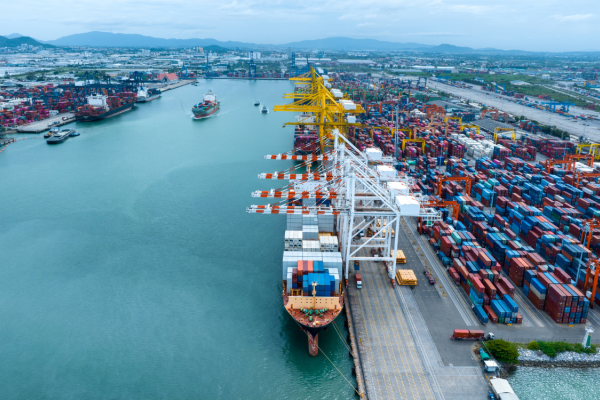
Pushpa Pandya
Published: April 15, 2025
What is a Notice of Readiness?
Under a voyage charterparty a NOR is a document of delivery of the vessel into the charter service and it indicates that the vessel is at the disposal of the voyage charterer. Failure of the vessel to tender NOR within the agreed laycan may give Charterers the right to cancel the charter.
For the purposes of the laytime/demurrage regime in the charterparty it is usual that tender of a valid NOR will be the initial trigger for time to begin to run in accordance with the other charterparty terms.
It must be factually accurate at the time that it is given and not at some anticipated time in the future1. If the statements in the NOR are incorrect, the notice will be invalid and ineffective to start laytime.
What are the methods of tendering a valid NOR?
The Master should be aware of the permissible methods of tendering NOR under the specific charterparty.
In The Port Russel2 the Commercial Court held that listed methods of tendering NOR in BP Voy 3 clause 19 (i.e. by letter, facsimile transmission, telegram, telex, radio or telephone, and if given by radio or telephone subsequently be confirmed in writing) was exclusive and that an email was not a permitted method to constitute a valid NOR under that fixture.
What are the general requirements for a valid NOR?
A NOR must record that at the time the notice was given that the vessel was (i) at the place agreed in the charterparty to tender the NOR; and (ii) in all respect ready to commence loading or discharging.
The vessel must have reached the agreed place
The Owner must arrange for the vessel to get to the agreed destination. When the vessel has arrived at the place agreed in the charterparty where the NOR can be tendered and is at the immediate and efficient disposition of the Charterers, it is referred to as an “arrived ship”.
What is the agreed destination and whether the vessel is an “arrived ship” will depend on the terms of the contract.
The agreed place could be a port, a berth or an anchorage. The agreed destination makes a significant difference to the allocation of risk of delay.
What is a Port Charter and how is “Port Limit” defined?
It is a charterparty that describes the load port/discharge port, for example “one safe port, Liverpool”.
In order to tender NOR, where the vessel is not able to sail straight to the berth, the vessel must be within the port limits of the nominated port, and at the immediate and effective disposition of the Charterer.
“Port Limit” usually includes any area within which the vessel is customarily asked to wait by the authority and over which the Port Authority exercises control over the movement of shipping.
In the Johanna Oldendorff3, the vessel was ordered to discharge a cargo of grain at Liverpool/Birkenhead. The vessel was anchored at Mersey Bar anchorage which was the usual waiting place for grain ships to proceed upriver, but 17 miles from the nearest discharging berth. The House of Lords found the vessel was not an arrived vessel and the NOR tendered was invalid.
Can the “Port Limit” be extended?
To avoid disputes as to whether the vessel is an arrived ship in a port charter, it is common to include the provision “whether in port or not” (WIPON). Where the charterparty contains this provision, the Master would be entitled to tender NOR once the vessel is at the port but must wait outside the port limits due to congestion, irrespective of whether it is within the official port limits4.
Berth Charter - is it always evident whether the charterparty is a berth charter?
Where the charterparty describes the destination as a named berth, or there is an express right to nominate a berth, the charterparty may be a berth charterparty5. In a berth charter, NOR can only be tendered when the vessel has actually berthed. Risk of congestion for the berth rests on Owners.
However, it may not always be clear whether the fixture is a berth charter. For example, a fixture which provided for the vessel to “sail and proceed to one or two safe ports East Canada or Newfoundland, place or places as ordered by Charterers and/or shippers or so near thereunto as she may safely get” was held to be a berth charterparty and the vessel was not an arrived ship until she reached the nominated berth6.
It is also common for a charterparty to contain the provision “whether in berth or not” (WIBON) which serves to advance the time the NOR can be tendered to before the vessel is at berth. This provision has the effect of transferring the risk of delay due to congestion to the Charterers. The provision applies if the berth is not available due to congestion, but not where the berth is unreachable due to other reasons such as weather7.
Ready in all respects
Once the vessel has arrived at the agreed destination, laytime will only commence if the vessel is in fact ready in all respects. The vessel “must be ready to obey the Charterer’s order whenever they are given”8. This encompasses two general features, physical readiness and legal readiness.
How is physical readiness determined?
Physical readiness means that the cargo holds must be clean, dry and in every way fitted to carry the intended cargo and any equipment which is relevant to loading or discharging must be ready e.g. cranes, hatches, pumps etc.
For example, vessels have been deemed not to be ready:
If the holds are damp after being cleaned and the cargo is likely to be damaged by being loaded into the hold, the ship will not be regarded as “ready to load”.
If the cargo space is overstowed with cargo which must be removed prior to the cargo operations.
If the cargo space is infected or requires fumigation10.
Cleanliness is an important aspect of physical readiness. It is a question of fact to be determined in accordance with the particular trade and the characteristics and degree of particularity of the cargo, and the charterparty requirements. The wider the range of cargoes that can lawfully be carried under a particular charter, the more general the shipowner’s responsibility as to the degree of cleanliness required.
Are the requirements stringent and how can they be counteracted?
Yes, if the vessel if not physically ready, the NOR is likely to be held invalid.
To mitigate the strict requirements of the common law in relation to the physical condition of the holds or tanks prior to presentation of NOR, it is common for parties to agree that NOR can be tendered on arrival at the load in order to commence laytime running and that, in the event the vessel’s holds do not pass an inspection, that time will be suspended from running for the period needed to remedy the condition.
If the vessel is found during that inspection not to be ready, and such a clause is included in the charterparty, because the parties have included an alternative remedy the NOR remains valid, provided there is no evidence that that the NOR was tendered with knowledge that the contents were untrue.
How is legal readiness established?
Legal readiness requires the vessel to have all documentation in order so that the vessel can proceed immediately to commence cargo operation. This includes having in place any clearance or entry requirements or approvals.
Owners’ (lawful) exercise of lien for GA will not prevent tender of valid NOR12. And provided it does not prevent the vessel shifting within the port and conducting cargo operations, a vessel being under arrest will not prevent a valid NOR being tendered13.
How does free pratique pertain to the NOR?
Free pratique is part of the legal readiness of the vessel. The term “free pratique” is regarded as the “official permission from the port health authorities that the ship is without infectious disease or plague and the crew is allowed to make physical contact with shore; otherwise, the ship may be required to wait at quarantine anchorage for clearance” .
At common law the need for free pratique will not prevent a notice of readiness from being given if there is no reason to suspect that free pratique will not be granted as per The Delian Spirit15.
However, where the charterparty has an express requirement for the vessel to be in “in free pratique” when NOR is tendered, Owners will not be able to rely on The Delian Spirit even where the crew were evidentially healthy when NOR was tendered16. The Owners will bear the risk of delays in obtaining free pratique.
Charterparties may also contain other provisions which allow the Master to tender NOR without having completed formalities such as obtained free pratique (“whether in free pratique or not” (WIFON) or custom clearance (“whether custom cleared” (WCCON)).
Of course, by giving the NOR the Master is affirming that his vessel is ready – if it is not and there is delay that is more than a formality - such clauses will not assist Owners to advance the commencement of laytime. In London Arbitration 11/00 the charter allowed for the NOR to be tendered “whether in free pratique or not”. The vessel arrived and tendered her NOR but could not berth for various reasons. One of which included invalid vaccination certificates for some of the crew (including the Master). Free pratique was not granted until the vessel berthed. The Owners’ reliance on The Delian Spirit was unsuccessful because obtaining free pratique was more than just a mere formality given the requirement to obtain certificates.
Is a NOR invalid if tendered outside specified time?
Some charterparties require the NOR to be tendered within certain times for example, during office or business times.
The charterparty in The Petr Schmidt17 required the notice of readiness to be tendered within 06.00hrs to 17.00hrs local time, with laytime to commence six hours from receipt of the notice. Although the vessel was physically ready to discharge, the Master tendered NOR outside these times. The Court of Appeal held that the notice tendered outside the required times was non-contractual, but deemed to be tendered when the Charterers would receive it during the next opening of the specified times.
What are the consequences of an invalid NOR?
If the NOR is invalid when given, it remains invalid. It will not be “cured” if the incorrect facts therein later become true.
For example, if the notice is invalid because the ship is not in fact ready when the notice is given, it does not become valid if and when the ship is subsequently made ready .
Laytime will only commence if a further NOR is validly tendered and the vessel is in fact in the agreed location and ready in all respects.
How does a waiver/estoppel impact the validity of the NOR?
Where Charterers accept an invalid notice with full knowledge of the defect, they may be deemed to have waived the defect and will be estopped from relying upon the defect/invalidity.
Whether there has been such an acceptance will depend on the facts in each case. For a waiver to be valid, Charterers must have actual knowledge of the defect in the NOR and, despite this, elect not to exercise his contractual right to the tender of a valid NOR. Estoppel requires a positive and unequivocal statement by the Charterers that he will not insist upon his legal right against Owners. Silence will not do.
The effect of an incorrect NOR was considered by the Court in The Happy Day19. The NOR at discharge port was to be “given to the Receivers/Agents during normal local office hours and laytime to start counting at 8am next working day” [WIBON, WIPON]. The vessel arrived off the disport and tendered NOR but was unable to enter the port having missed the tide. The Master tendered NOR to the receiver’s agents, who endorsed it “received”. The vessel berthed the next day and commenced discharging. Owners had purported to give notice from outside the berth in circumstances where there was no congestion at the berth. No further notice was tendered. Charterers rejected Owners’ demurrage claim on the basis that the notice was invalid and claimed laytime had not commenced and they were entitled instead to despatch. The Court accepted that the NOR was invalid. The fact that Charterers had commenced discharge did not mean that Charterers had given up their right to a validly tendered NOR. However, the commencement of discharge by Charterers amounted to a waiver by conduct of the invalid NOR. Laytime, therefore, began on commencement of discharge in accordance with the charterparty terms.
Conclusion - What should the Master always bear in mind to protect Owner's interests?
The importance of a valid tender of NOR cannot be over-emphasised. Some practical steps to seek to prevent any arguments as to the validity of the NOR may include:
The Master should always be aware of all the charterparty terms which affect the valid tender of NOR and should comply with them.
If there is any doubt as to the validity of the NOR tendered, the Master should re-tender the NOR on a without prejudice basis to any NOR tendered previously.
Where the Master is unable to complete formalities for reasons unconnected with the vessel, the Master should issue LOP to all parties and retender NOR once formalities have been completed.
The golden rule is to tender an NOR and keep re-tendering if there are any doubts or changes in position or circumstances.
Whilst the intent of this guide is to provide an overview of the principles underpinning NORs, it is important to highlight that it is not a substitute for legal advice, and Members of the Club are encouraged to approach their usual contacts at the Club for assistance in specific matters.
1 The Mexico 1 [1990] 1 LLR 191
2 [2013] EWHC 490 (Comm)
3 [1973] 2 Lloyd's Rep. 285
4 The Adolf Leonhardt [1986] 2 Lloyd’s Rep 395
5 Merida [2010] 1 LLR 274
6 Stag Line v Board of Trade [1950] 83 Ll. L. Rep. 356
7 The Kyzikos [1987] 1 Lloyd’s Rep 48
8 The Tres Flores [1973] 2 Lloyd’s Rep 247
9 The Massalia (No2) [1960] 2 LLR 352 and The Mexico 1 [1990] 1 LLR 501
10 The Epaphus [1986] 2 LLR 387
11 The Linardos [1994] 1 LLR 28
12 Gill & Duffus SA v Rionda Futures Ltd the “Opal Islands” [1994] 2 Lloyd’s Rep 67.
13 London Arbitration 4/05
14 ” The “Eagle Valencia” [2010] 2 Lloyd's Rep. 257. https://www.steamshipmutual.com/publications/articles/eagle0211
15 [1971] 1 Lloyd's Rep. 506
16 London Arbitration 14/86
17 [1998] 2 Lloyd’s rep 1 CA
18 The Mexico 1 [1990] 1 Lloyd's Rep. 50
19 [2002] EWCA Civ 1068


